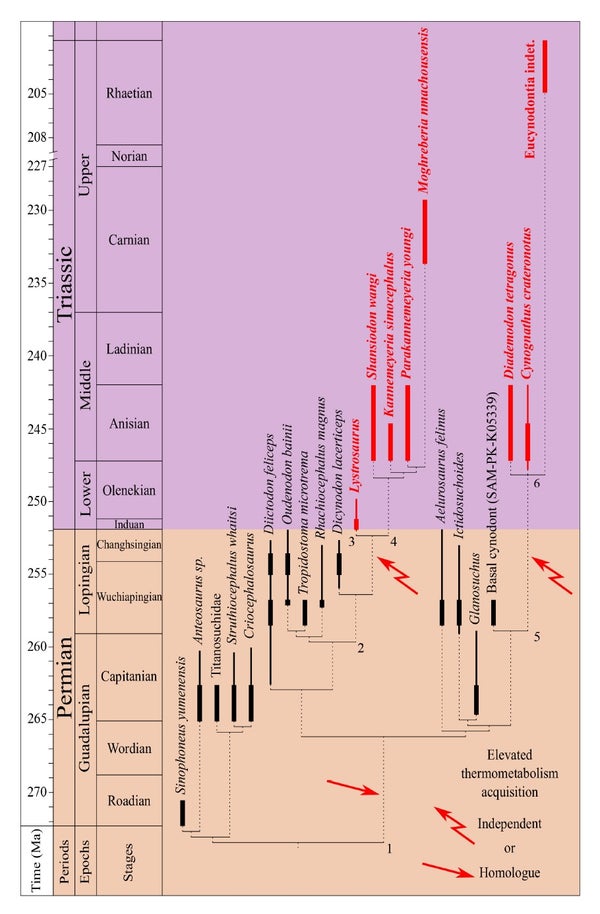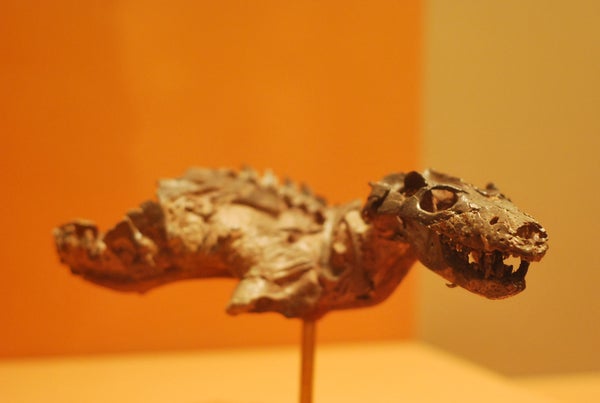This article was published in Scientific American’s former blog network and reflects the views of the author, not necessarily those of Scientific American
We’re entranced with where we came from. Who were our ancestors? What were they like?
Of course, this only goes up to a point. The further back in time you go, and the less human the creatures look, the less attention we tend to pay to our predecessors and relatives. Maybe that’s why cynodont isn’t really a household word while Neanderthal is. But the human story isn’t just about walking upright or bashing rocks to make stone tools. We’re mammals, after all, part of a much wider family with some pretty outstanding traits. For example, we make our own heat and maintain a more or less constant body temperature. A new study outlines when our protomammal antecedents evolved this amazing capability.
Up until now, the origins of our endothermy was a mystery. Physiology doesn’t exactly fossilize, and so paleontologists had to look to proxies for clues. Fur is undoubtedly associated with keeping internal fires running, for example, and the earliest furred fossils yet known are about 165 million years old. Brain structures associated with whiskers, as well, suggest an even earlier date of about 240 million years for hair, hinting that the characteristic “warm bloodedness” of mammals had evolved by then, too.
On supporting science journalism
If you're enjoying this article, consider supporting our award-winning journalism by subscribing. By purchasing a subscription you are helping to ensure the future of impactful stories about the discoveries and ideas shaping our world today.
But there is another way.
In a new study, paleontologist Kévin Rey and colleagues looked to Oxygen isotopes in Permian and Triassic bones to estimate what the body temperatures of protomammals were like. This approach has been used before on other groups of organisms – for example, marine reptiles – and relies on investigating the relationship between chemical signatures and body temperature. What the paleontologists found puts a new date on when our ancestors and relatives started to run hot.
The researchers sampled the bones of a variety of synapsids – the group that contains mammals and their close relatives – that lived at different latitudes during the Permian and Triassic. The idea, Rey and colleagues write, is that synapsids whose body temperatures fluctuated with the surrounding environment would show a scattering of Oxygen isotope values while those that maintained constant body temperatures would not be affected by geographical changes and would be less variable. They determined that at least two lineages of protomammal showed signs of endothermy – a group of pig-like, tusked creatures like Lystrosaurus, and weasel-like animals called eucynodonts that included the line that would eventually spin off the first true mammals.

A phylogeny of synapsids indicating where elevated metabolisms may have evolved. Credit: Rey et al. 2017
Both groups seem to have evolved elevated metabolisms by the end of the Permian, between 259 and 252 million years ago. The question is why. Rey and colleagues forward a couple of possibilities.
The global climate was cooling by the end of the Permian, the researchers note, and was followed by rapid global warming during the catastrophic extinction that ended the period. Perhaps the swings of climate selected for animals that could generate their own body heat – and perhaps even keep them stable – during this stressful period in life’s history.
More than that, endothermy is often associated with rapid growth rates. This may have allowed endothermic protomammals to reach reproductive maturity earlier than their relatives, Rey and coauthors suggest, letting them keep their lineages going as other, slow-growing forms perished. In short, the paleontologists suggest, endothermy “might have enabled certain therapsids to survive the intense climatic change of that time and conquer the newly vacant niches,” allowing our ancestors and some of our relatives to survive the worst mass extinction of all time.
Reference:
Rey, K., Amiot, R., Fourel, F., Abdala, F., Fluteau, F., Jalil, N., Liu, J., Rubidge, B., Smith, R., Steyer, S., Viglietti, P., Wang, X., Lécuyer, C. 2017. Oxygen isotopes suggest elevated thermometabolism within multiple Permo-Triassic therapsid clades. eLIFE. doi: 10.7554/eLife.28589
